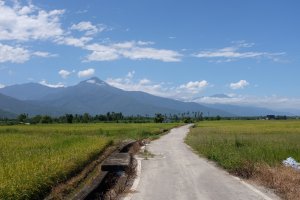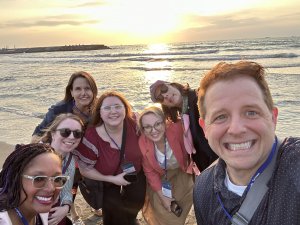In 2016-2017, I conducted research for my dissertation on early medieval Chinese literature in Taipei as a Fulbright Fellow. Upon arriving in Taipei in early September, my husband and I set to work trying to find a home for the year. Over the summer, I had spent hours “researching” life in Taipei (reading food blogs), but our main concern upon arrival was finding a place accessible to our respective research institutions, National Taiwan University and Academia Sinica. After a few disheartening weeks sifting through online apartment listings, we found a place near Yongkang Jie, a street in Da’an District. Before moving there, I had only been to Yongkang Jie once, for a quick dinner. It was a just a few days after arriving in the city, and on the rainy evening the bright, narrow alleys were somewhat disorienting. I remember thinking, “What a neat area! I’m glad I got to see it once…”
At the time, I didn’t have a strong sense of the history of the neighborhood, whose distinctive character has been shaped over the years by community activism, government bureaucracy, and commerce. Once the preserve of Japanese officials, Yongkang Jie and the adjacent Qingtian neighborhood, originally developed as housing for Japanese faculty members at the colonial institutions of higher education, still retain traces of the colonial era in the form of old trees and homes spared from destruction over several decades of intensive urban development. After being designated as culturally significant sites in the 1990s and early 2000s, several former residences were renovated and turned into public-facing businesses, such as restaurants or galleries.
One building, located on the way to our preferred fruit seller, was under renovation for most of the time that we lived there, and for months, we speculated what it would become. Near the end of our stay, a sign on the wall declared it would soon be a center of Confucian learning and calligraphy lessons. Other structures persisted, apparently undisturbed by forces other than wind and water, as havens for the neighborhood cats that subsist on bowls of food left out each evening. On my walk home from the NTU campus, I would pass by wood and tile residences mostly obscured by crumbling concrete walls. Surrounded by overgrowth, they felt like ghost houses in contrast to the smart bookstores and ice cream shops nearby. With the apparent lack of human activity on the premises, it felt all the more spooky to walk by at night and catch a glimpse of electric light in a window. When the papaya fruits in one garden began to approach ripeness, after months of incremental growth, I wondered if anyone would cut them down and eat them.
On Yongkang Jie proper, tourists spill off of the sidewalks and onto the street every day of the year. Coming from the nearby Dongmen MRT Station, orderly lines of people wait at the most famous dumpling restaurant, the most famous mango ice purveyor, the most famous onion pancake stand, and the many bubble tea counters. At each of these, the staff seem to be made of steel, dispatching long lines of English-, Japanese-, and Korean-speaking tourists with admirable efficiency and cheer. Thanks to this robust tourist traffic, we had within five minutes of our front door beef noodles, soup dumplings, sushi, hot pot, and American diner food, not to mention the offerings of the many 7-11 and Family Mart locations in the vicinity. My experiences living in tourist towns in the United States led me to be wary of restaurants located directly on the main drag, but over time my skepticism abated and I found even the most seemingly tourist-oriented places to be at least reasonable in price and quality.
In this neighborhood of fierce competition and high rents, restaurants and shops come and go rapidly. The first casualty after we moved in was a Croissant Taiyaki cart. For weeks, we walked by its old spot hoping that there had been a misunderstanding, that grilled, custard-filled croissants would return to us. It was not meant to be, and we soon moved on. A few months later and one block over, a take-away coffee stand opened, occupying a tenuous middle ground between the pricey espresso cafes and cheap juice and iced tea stands that line the streets. Manning the counter was a friendly young mother, whose seven-year-old son provided the drawings on the narrow walls. As they continued to adjust the prices and inventory, I hoped that business was going well enough to keep them going for a long time to come.
Amid the blocks of tea and tea paraphernalia shops, restaurants, and boutiques, there is also a small park, with the familiar metal playground equipment found in parks throughout neighborhoods in the city. Tall banyan trees give shelter from the sun (and a haven for mosquitoes and the occasional rat), and benches provide a place to poke at bags full of fried snacks purchased from the surrounding area. Well into evening, the park is full of children running at full tilt and jostling one another for dominance on the monkey bars. Off to one side sat an unassuming bust of Chiang Kai-shek that I did not notice until after it was defaced on February 28th, Taiwan’s Peace Memorial Day. (It is but one of several commemorative statues on the island to have met with hard times in recent years.) For a few weeks, it was replaced by a sign noting that it had been taken away for repairs. Not long after its return, we found the bust covered by blue tarp, its base marked with smudges of hastily scrubbed graffiti. The future of the bust, which at one time occupied the center of the park, was unclear. For the rest of our stay, at least, it remained under wraps.
We passed through this park at least once a day and often happened upon commercial events and community celebrations, from the scheduled weekend bazaar to the occasional church performance. At the tail end of the Lunar New Year season, the park hosted a Lantern Festival celebration. For days, a gate hung with lanterns sporting the names of local businesses lent the park a festive atmosphere. On the evening of the Lantern Festival, there were several performances, including a synchronized yo-yo performance put on by students from the neighborhood middle school; an impressively athletic lion dance, also performed by middle-schoolers; and a woman singing Hakka love songs, with lyrics displayed on an alluring KTV video projected on the screen behind the stage. The centerpiece of the event was a large float that had been placed in the center of the park. Its cheerful pair of chickens, the zodiac animal for the New Year, illuminated the space while emitting soft, comforting clucks. Toward the end of the evening, a lyrics sheet was distributed, and we all sang the charming, chicken-themed song enjoining children to wake early, study late into the night, and respect their parents. Finally, after giving thanks to the sponsoring individuals and businesses, a team of Daoist officiants led the chicken float in a procession through the neighborhood, and everyone else lined up in the park to receive their own red paper lanterns lit by LEDs.
On another day, I was sitting in the park with a friend after escaping from the confines of a coffee shop unfortunately located next door to a loud construction project. A middle-aged man started setting up speakers nearby and asked us if we didn’t mind moving. As we got to talking, he explained that he was part of a band of native Okinawans and Aboriginal Taiwanese musicians who were taking their music — folk tunes mixed with Latin rhythms — on tour. When I returned to the park a few hours later with my husband, the performance in full swing. Alongside neighborhood families, passing tourists that had slowed down to survey the scene, and at least one lone, visibly intoxicated foreigner, we enjoyed rousing renditions of “La Bamba” as well as Okinawan and Aboriginal Taiwanese songs. Caught up in the moment, we bought tickets for their show later in the week at the Riverside Red House Performance Hall in Ximending. The band was just as good the second time around, but in the sanitized atmosphere of the auditorium, the polite attention of the mostly seated audience did not generate the same magic as the impromptu crowd in the park on Yongkang Jie.
When choosing a place to live for the year, my husband and I hadn’t intended to install ourselves on the margins of a popular tourist destination, but it ended up enriching our experience significantly. There are lots of features of this small corner of the city that I only came to appreciate after months of walking around, many more than I could fit in one essay, and I’m grateful to have had the opportunity to explore Taipei and Yongkang Jie in this gradual and organic way, while being supported in my research by the Fulbright program and my hosts at National Taiwan University.
For additional information on the development of the Yongkang and Qingtian neighborhoods:
Huang, Li-Ling. “Urban Politics and Spatial Development: The Emergence of Participatory Planning.” In Globalizing Taipei: The Political Economy of Spatial Development, edited by Reginald Yin-wang Kwok, 78-98. New York: Routledge, 2005.
Matsuda, Hiroko. “Whose Home? Cultural Pluralism and Preservation of Japanese Colonial Heritage in Taipei City.” In Sites of Modernity: Asian Cities in the Transitory Moments of Trade, Colonialism, and Nationalism, edited by Wasana Wongsurawat, 85-102. Berlin: Springer, 2016.





